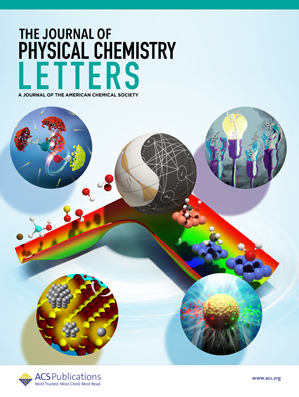Ambipolar Behavior of Hematite Surface Induced by Water Adsorption Revealed under Environmental Conditions
IF 4.8
2区 化学
Q2 CHEMISTRY, PHYSICAL
引用次数: 0
Abstract
In this work, we determine the electronic structure and charge carrier dynamics of α-Fe2O3(0001) ultrathin film deposited on Pt(111) as a function of water pressure by combined near ambient pressure–time-resolved photoelectron spectroscopy (NAP-TR-PES) measurements and DFT calculations. Under ultrahigh vacuum (UHV) α-Fe2O3 exhibits the expected typical n-type semiconductor behavior with a surface photovoltage (SPV) shift of 31 meV. Surprisingly, when exposed to water a completely different comportment appears. At a partial pressure of water of PH2O = 0.02 hPa, a much smaller SPV (7 meV) appears that is shifted in the opposite direction, which is thus characteristic of a p-type semiconductor. Finally, at PH2O > 0.1 hPa, SPV is canceled, which is consistent with a layer of metallic nature. DFT calculations explain these experimental findings well as originating from a modification of the surface structure and electronic properties of the layer consecutive to water adsorption. It is shown that the Fermi level position in the band gap of hematite depends on the quantity of adsorbed water, giving rise to the ambipolar behavior of the surface, which is able to transport both negative and positive charges when exposed to the appropriate water pressure.

在这项研究中,我们通过近环境压力时间分辨光电子能谱(NAP-TR-PES)测量和 DFT 计算,确定了沉积在 Pt(111) 上的α-Fe2O3(0001) 超薄薄膜的电子结构和电荷载流子动力学与水压的函数关系。在超高真空(UHV)条件下,α-Fe2O3 表现出预期的典型 n 型半导体特性,其表面光电电压(SPV)偏移为 31 meV。令人惊讶的是,当暴露在水中时,却出现了完全不同的特性。在 PH2O = 0.02 hPa 的水分压下,SPV(7 meV)出现了更小的反向偏移,这就是 p 型半导体的特征。最后,在 PH2O > 0.1 hPa 时,SPV 被取消,这与金属层的性质一致。DFT 计算很好地解释了这些实验发现,它们源于水吸附后对该层表面结构和电子特性的改变。结果表明,赤铁矿带隙中费米级的位置取决于吸附水的数量,这就导致了赤铁矿表面的两极行为,当暴露在适当的水压下时,它既能传输负电荷,也能传输正电荷。
本文章由计算机程序翻译,如有差异,请以英文原文为准。
求助全文
约1分钟内获得全文
求助全文
来源期刊

The Journal of Physical Chemistry Letters
CHEMISTRY, PHYSICAL-NANOSCIENCE & NANOTECHNOLOGY
CiteScore
9.60
自引率
7.00%
发文量
1519
审稿时长
1.6 months
期刊介绍:
The Journal of Physical Chemistry (JPC) Letters is devoted to reporting new and original experimental and theoretical basic research of interest to physical chemists, biophysical chemists, chemical physicists, physicists, material scientists, and engineers. An important criterion for acceptance is that the paper reports a significant scientific advance and/or physical insight such that rapid publication is essential. Two issues of JPC Letters are published each month.
 求助内容:
求助内容: 应助结果提醒方式:
应助结果提醒方式:


